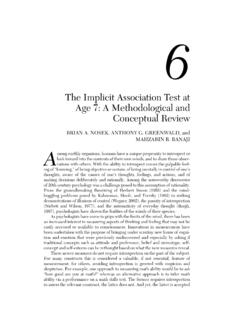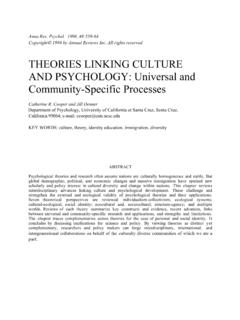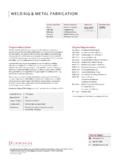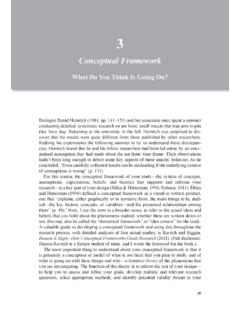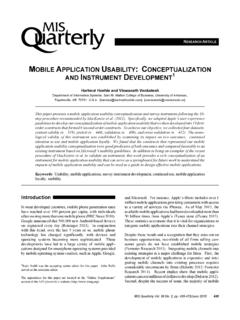Transcription of Risk Attitude Scales: Concepts, Questionnaires, …
1 BERND ROHRMANN Risk Attitude Scales: Concepts, Questionnaires, Utilizations Project Report University of Melbourne/Australia - January 2005 == Available at == Abstract While risk behavior has been studied intensely and a large number of risk perception studies are available , far less research exists regarding people's mind-sets towards risk-taking, , risk attitudes , such as, risk propensity and risk aversion. These can be conceptualized as two poles of a one-dimensional Attitude towards risk-taking but also as two separate concepts. It is widely assumed that people differ considerably in their Attitude towards risks , ranging from cautiousness to risk-seeking and even pleasure in risk-taking. However, there is no convincing evidence that this presumed dimension is a general trait (rather than a state, or a domain-specific Attitude , , distinct for physical, financial, or social risks people may encounter).
2 Furthermore, basically no established measurement tools exist. In this contribution, the conceptualization of risk attitudes will be outlined, several new instruments (Risk Orientations questionnaire , Risk Propensity questionnaire , Risk Scenarios questionnaire , Risk Motivations questionnaire ) presented and empirical findings about the characteristics of these scales examined, including contingencies with related constructs ( , venturesomeness, sensation-seeking, impulsiveness). The investigations were conducted in three countries, using versions prepared in English, German and Chinese language. All instruments are based on the respondents' view of their principal standpoint in risk situations (rather than hypothetical gambles). The results so far indicate that risk attitudes are multi-dimensional, that individual risk orientations are not necessarily consistent across domains, and that the motivations for accepting risks vary considerably, depending on the type of hazard.
3 Finally, potential applications and implications for further research are discussed. Postscriptum (2008) An updated version of this research report has been submitted to the Journal of Risk Research; a final text will be produced when the cross-cultural analyses are completed. Contact Address: Associate Professor B. ROHRMANN University of Melbourne, Dept. of Psychology, Vic 3010, AUSTRALIA. E-Mail WebSite: ROHRMANN - Risk Attitude Scales 2 1 The conceptualization of risk attitudes The issue Do people like to go for a risk, and would that be a good thing, or rather not? Consulting the wisdom of proverbs provides a whole range of 'yes' and 'no' attitudes : "Nothing ventured, nothing gained", "It's better to be safe than sorry", "When fortune smiles, embrace her", "Look before you leap", "Who dares wins", "A bird in the hand beats two in the bush".
4 In fact, concepts such as risk propensity, risk-seeking versus risk-aversive, risk-taker and so on are widely used and seen as existing by most laypeople and many risk researchers. They are postulated - implicitly or explicitly - as personality trait(s) by some authors but not (yet?) convincingly validated as such. However, it seems that these constructs are inconsistently and sometimes illogically defined in the literature. While risk behavior has been studied intensely and a large number of risk perception studies are available, far less research exists regarding people's mind-sets towards risk-taking, , risk attitudes , such as, risk propensity and risk aversion. However, this issue is highly relevant to risk research: if systematic individual differences in risk attitudes exist, then this needs to be considered in risk perception research as well as in risk communication aiming at modifying the risk behavior of particular people or groups.
5 Definition of main concepts Given the ambiguity of many concepts dealt with in risk research, it seems important to clarify the main notions. In this project, the main concepts are understood as follows (cf. Rohrmann 1998): RISK: The possibility of physical or social or financial harm/detriment/loss due to a hazard. This is the (dominating) 'negative' perspective; however, there is also a neutral perspective, , risk = uncertainty about the outcomes (good and/or bad ones) of a decision; and a positive perspective, , risk can mean: 'thrill' (danger-induced feelings of excitement) PERCEIVED RISK MAGNITUDE A person's judgment (opinion, belief) about how large the risk associated with a hazard is (regarding negative outcomes) RISK Attitude A generic orientation (as a mind-set) towards taking or avoiding a risk when deciding how to proceed in situations with uncertain outcomes.
6 Risk propensity: Attitude towards taking risks ; Risk aversion: Attitude towards avoiding risks . RISK ACCEPTANCE/REFUSAL Decisions about how acceptable a risk is in individual or societal terms (in principal or de-facto, , in a concrete situation) RISK BEHAVIOR The actual behavior of people when facing a risk situation ROHRMANN - Risk Attitude Scales 3 The definition of risk propensity and aversion proposed above means that these constructs are understood as attitudes (in line with how this term is used in social psychology) and are to be measured accordingly. It is also important to be clear about what a scale actually captures: most "risk" questionnaires, even those labelled "risk-taking" or "risk behavior questionnaire ", do not measure behavior; rather, cognitions which precede the actual behavior.
7 Literature review Research into the Attitude people hold towards taking or avoiding risks mostly evolved in three contexts: decision processes, social psychology, and personality models. Mind-sets such as risk-seeking are a core factor in models of choice and decision (cf., , Edwards 1954, 1992, Hogarth 1987, Kahneman & Tversky 1979, Weber & Camerer 1987). A main interest in early studies on risky behavior was how individuals deal with risk in a group situation, and whether "risky shifts" occur or not ( , Kogan & Wallach 1964, 1967, Lamm et al. 1970, Rim 1964). There is also a long-standing debate within personality researchers whether risk propensity should be treated as a personality trait ( , Klebelsberg 1969, Knowles et al.)
8 1973, Levenson 1990, Pennings & Smidts 2000, Schwenkmezger 1977, Shure & Meeker 1967, Trimpop et al. 1999; overview in Bromiley & Curley 1992) and how risk orientations vary across hazard types and domains ( , Jackson et al. 1972, Nicholson et al. 2005, Slovic 1962, 1972). Within economic psychology, risk attitudes received considerable attention as well ( , McCrimmon & Wehrung 1986, Schubert et al. 1999, Waerneryd 1996). From a clinical viewpoint, researchers explored whether unusual behaviors can be linked to risk attitudes ( , Andresen 2000, Eysenck & Eysenck 1978, Horvath & Zuckerman 1993) - the title of Jackson & Wilson's article (1993), "Mad, bad or sad? The personality of bikers" is a nice example for this line of work.
9 More recently, gender differences in risk attitudes have been looked at ( , Andresen 2000, Arch 1993, Byrnes et al. 1999, Schubert et al. 1999, Siegrist et al. 2002), induced by multifold observations that women show high-risk behavior less often than men. Furthermore there is special literature on "risk" as something appealing and pleasant, that discusses why some people in some circumstances are attracted rather than scared by risk situations ( , Brengelmann 1991, Keyes 1985, Lupton 1999, Schneider & Rheinberg 1996, Semler 1994). Some of these researchers developed tests for risk propensity or related concepts, including Andresen 1995, Dahlbaeck 1990, Eysenck & Eysenck 1978, Farley 1987, 1991, Keinan et al. 1984, Krueger & Amelang 1995, Weber et al. in press, Wolfram 1982, Zalieskiewicz 2001; partial overview in Harrison et al.
10 2005. See Table 1 for a list of questionnaires (in English) which either are or contain risk propensity and/or risk aversion scales. ROHRMANN - Risk Attitude Scales 4 Table 1: List of questionnaires aiming at risk propensity mind-sets Questionnaires, based on statements about risk-taking orientations: EVQ Venturesomeness questionnaire (Eysenck & Eysenck 1978) TRA Tension/Risk/Adventure scale (Keinan et al. 1984), DQS Decision Q-Sort (Wolfram 1982, English version Rohrmann 1991), DRP Risk-taking Propensity (Dahlbaeck 1990) TPF T-type Personality scale (Farley 1991) ROQ Risk Orientation questionnaire (Rohrmann 1997) < previously called ARD> LRP Risk propensity (Lindemann 1997) (x) Stimulating-Instrumental Risk Inventory (Zaleskiewicz 2001) (x) Domain-specific Risk Attitude scale (Weber/Blais/Betz in press) Related constructs/instruments: SSS Sensation Seeking scale (Zuckerman 1991) <version VI>, FAD Active/decisive Style (Franken 1988) EIQ Impulsiveness questionnaire (Eysenck & Eysenck 1977) New instruments - resulting from this project.



